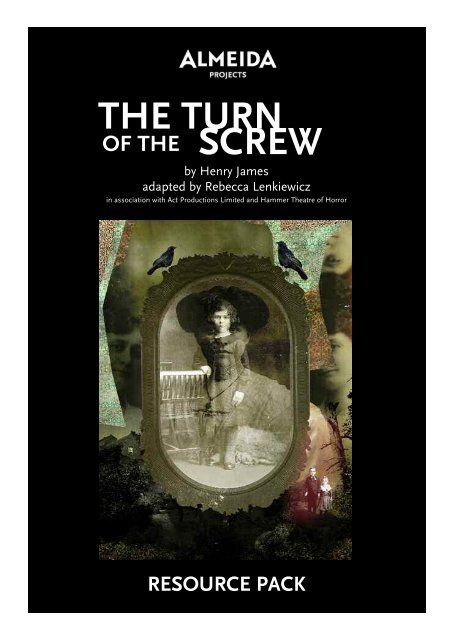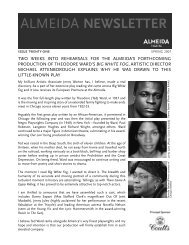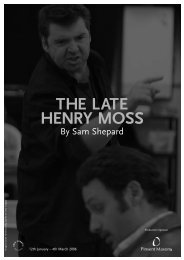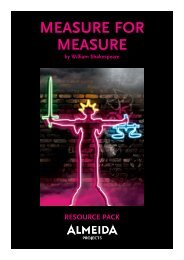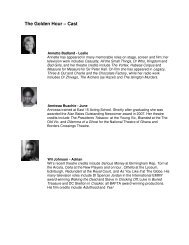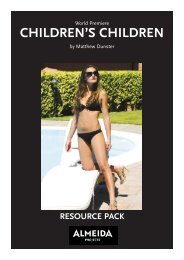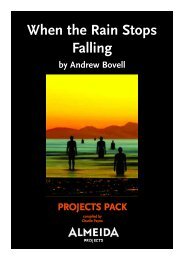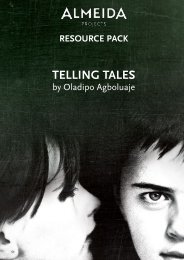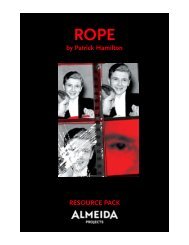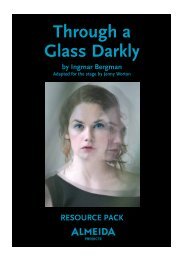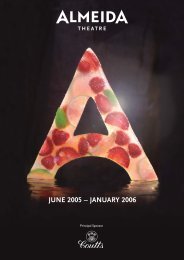Resource Pack - Almeida Theatre
Resource Pack - Almeida Theatre
Resource Pack - Almeida Theatre
Create successful ePaper yourself
Turn your PDF publications into a flip-book with our unique Google optimized e-Paper software.
Production Credits18 January - Saturday 16 MarchTHE TURNOF THE SCREWby Henry Jamesadapted by Rebecca LenkiewiczCast in order of appearance:GovernessAnna MadeleySackvilleOrlando WellsMrs GroseGemma JonesFloraIsabella Blake ThomasEmilia JonesLucy MortonMilesLaurence BelcherMiss JesselCaroline BartleetPeter QuintEoin GeogheganCreative Team:DirectorDesignLightingSoundComposerVideo DesignerIllusionistCastingChildren’s CastingDialectVoiceMovementAssistant DirectorLindsay PosnerPeter McKintoshTim MitchellJohn LeonardGary YershonJack Henry JamesScott PenroseJulia HoranJo Hawes CDGJan Haydn RowlesRichard RyderImogen KnightAlex BrownProduction Team:Production ManagerDeputy Production ManagerCompany Stage ManagerDeputy Stage ManagerAssistant Stage ManagerCostume SupervisorHair and Wigs CreationWardrobe SupervisorDeputy Wardrobe SupervisorWigs, Hair andMake Up SupervisorsChief TechnicianLighting TechnicianSound TechnicianAssistant <strong>Theatre</strong> TechnicianProduction CarpentersStage CrewSet built bySet painted byCostumes byStage ManagementWork PlacementProduction andRehearsal photos byIgorAggi AgostinoLaura FlowersLorna SeymourKatie BarrettStephanie ArdittiLinda McKnightEleanor DolanRachel WriterAnna MorenaTina FrenchJason WescombeRobin FisherHoward WoodTony ForresterCraig EmersonDec CostelloBen LeeRobert WeatherheadMiraculous EngineeringKerry JarrettCospropMaia Alvarez StratfordNobby ClarkALMEIDA THEATREArtistic DirectorExecutive DirectorArtistic AssociateArtistic Associate(Maternity Cover)ALMEIDA PROJECTSCo-Director of ProjectsCo-Director of ProjectsCommunity andParticipation ManagerSchools and EducationManagerProjects AdministratorMichael AttenboroughJulia PottsJenny WortonLucy MorrisonSamantha LaneEJ TrivettBoris WitzenfeldCharlie PayneSarah Tarry<strong>Resource</strong> <strong>Pack</strong>: The Turn of the Screw3
Orlando Wells and Anna MadeleyPhoto Nobby Clark“The dead are gone,Miss. We’ve no rightto be disturbingthem.”Mrs GroseACT ONEScene 1In Harley Street. Sackville informally interviews a ladyfor the position of governess of his niece andnephew, who are orphans. Sackville mentions MrsGrose and their previous governess. He talks of hissister and how she drowned. He explains that hefinds it hard to be at Bly (where the children live)and that he will not visit. He insists that the womantakes complete control of running the house andchildren without interrupting him. The Governessaccepts the post. He mentions that the previousgoverness died near Bly. Sackville asks that theGoverness love the children as though they are herown.Scene 2In the parlour at Bly. Mrs Grose tells the Governessabout nine-year-old Flora and Miss Jessel, theprevious governess. Flora enters, bringing flowersfor the Governess. Mrs Grose encourages Flora toshow the Governess around Bly. In her bonnet Florahas a rook with a broken wing. She has named thebird Rip (“like all the people in the churchyard”).Flora mentions that her brother Miles will be hometoday and Mrs Grose corrects her, saying he is notarriving until next week. Mrs Grose leaves to returnlater, dismissing Flora and handing the Governess aletter. Miles has been dismissed from schoolpermanently as he is ‘an injury to others’ and hasPlot Summary<strong>Resource</strong> <strong>Pack</strong>: The Turn of the Screw4
Plot SummaryLucy Morton and Laurence BelcherPhoto Nobby Clark“The dead can do allsorts of things thatthey couldn’t do whenthey were alive.”Floraarrived at Bly. Miles enters, keen to see Flora, whoruns in to see him. The children leave and theGoverness tells Mrs Grose she will ask Miles laterabout the letter from school. She asks how MissJessel died.Scene 3At Bly in the parlour. Miles and Flora present aspectacular show to the Governess and Mrs Grose.Miles recites a riddle, Flora recites a poem for MissJessel and they both perform a song about Adamand Eve containing quite explicit adult lyrics. TheGoverness gets a mild headache. Miles recites hisown poem, one about dead people, demanding thathis audience have their eyes closed for theperformance. The children exit for a drink. TheGoverness quizzes Mrs Grose as to whom thechildren were talking about and for furtherinformation as to how Miss Jessel died. Mrs Groseexplains that she was in love with a man that workedat Bly. The Governess prays for the children by thefire.Scene 4In the schoolroom, Miles and Flora are practisingthe letter ‘O’ on chalkboards. The Governess has leftthem to read a letter from her father. She returnsand finds a sheet of paper on her desk; its contentsmake her blush. She asks Miles and Flora who put itthere, and they claim not to know. The children readand the Governess watches a stranger from thewindow. Miles claims he cannot see the stranger dueto the sun. He tells the Governess that someoneused to pretend to throw them off the tower, then heinsists that he was talking about their uncle,although it is very clear that he wasn’t.A dark object flies against the window. The noise ofchalk on slate begins, and it is not coming from thechildren. The Governess dismisses the children. Itstarts to rain. Flora returns to ask if she can feedRip. Flora leaves the Governess alone. A man’s faceappears at the window, staring at Miles’ desk. TheGoverness runs outside, then returns. The manappears inside the window. The chalk sounds beginagain. Mrs Grose enters and calls the children in outof the rain. The Governess describes the man shesaw. Mrs Grose believes it was Peter Quint, a formerservant at Bly, who is now dead.<strong>Resource</strong> <strong>Pack</strong>: The Turn of the Screw5
ACT TWOScene 5By the lakeside, Flora sings a song about valentines,also with inappropriate adult lyrics and theGoverness questions Miles about the note on herdesk. Mrs Grose reveals that Peter Quint was founddead with a wound to his head.The Governess sees a woman across the lake andinsists that it is Miss Jessel. Miles and Flora claimthey cannot see her. The Governess reveals to MrsGrose that she is sure the ghosts are after thechildren. Mrs Grose explains how the children sawmore of Quint and Jessel’s relationship than theyshould have done and how close Peter Quint andMiles were. The Governess believes the children aremarked and that she is there to save them; shekneels to pray.Scene 6In the Governess’s bedroom. She is looking atherself in the mirror and reading the note she foundon her desk. She hears a noise and looks outside.No one is there. Flora murmurs in her sleep, wakesbriefly, then returns to sleep.The Governess leaves her room and checks onMiles, asking why he is awake and if he saw anyoneenter her room. Miles recalls how Miss Jessel usedto hold him and cry. The Governess questions whathappened at school. He describes how he oncemade him a toy farm for his uncle. The Governesscomforts him and presses him to tell her whathappened with Peter Quint and Miss Jessel. Milesleans in to hear the Governess’s heart. Putting hishand on her left breast, he kisses her. She leaves himand returns to her room, telling herself it was PeterQuint and not Miles who kissed her. Flora is not inbed, but appears from behind the curtains. Florasleeps. Peter Quint and Miss Jessel appear at thewindow, embracing. They disappear and theGoverness climbs into bed, shaking with fear.Suddenly Peter Quint is lying next to her. Shescreams as he emerges from the bed and walks pasther, out of the room.Anna MadeleyPhoto Nobby Clark“I can’t help but lovethem. They’re soalone. And they feelso much.”GovernessPlot SummaryScene 7In the parlour at Bly. The Governess is sure theghosts of Peter Quint and Miss Jessel meet regularlywith the children. A storm is coming and she callsthe children inside. They are to go to church and theGoverness will follow them. Mrs Grose leaves withthe children and the Governess looks through theirwork. Miss Jessel suddenly appears at theGoverness’ desk, writing. She gestures to Miles’<strong>Resource</strong> <strong>Pack</strong>: The Turn of the Screw 6
Plot SummaryGemma Jones and Lucy MortonPhoto Nobby Clarkdesk and mimics his kiss with the Governess. TheGoverness asks the ghost what it was like with PeterQuint, but Miss Jessel disappears. THEY ARE MINEappears on the blackboard. Miles enters to say theyare waiting for the Governess, who explains shecannot come as she is meeting a friend.Scene 8The parlour that same day. Mrs Grose returns fromchurch and the Governess explains that she spoke tothe ghost of Miss Jessel and that she is mourningQuint. The Governess has sent for Sackville,intending to tell him everything. Miles plays thepiano to calm the Governess, whose head is aching,and she drifts off to sleep briefly. When she wakes,Flora has left the room and the Governess becomeshysterical with fear. Mrs Grose cannot find the childand the Governess is increasingly concerned thatPeter Quint is talking to her. They walk to the lake tolook for her.They spot a boat across the lake, but then Floraappears from the reeds. The Governess grabs herand demands to know where Miss Jessel is. Florainsists she can not see her; the Governess forcesFlora to look at the spot across the lake where sheappeared before. Mrs Grose cannot see the figure,and Flora becomes hysterical. Mrs Grose takes Floraaway and the Governess is distraught, convincedthat she has lost Flora to the spirits.“I say these thingsand I can feel thembeing pushed out ofme. And yet they’renot really my words.My thoughts.”MilesScene 9Miles plays the piano and the Governess enters.Papers fly from the piano, and as Miles picks themup, the piano lid crashes shut. Miles asks to seeFlora and the Governess forbids him. The Governessasks who else is in the room with them. Milessuggests she must be ill. The Governess presseshim about Peter Quint and Miss Jessel. He insultsthe Governess’ upbringing and her Father, thenleaves.Scene 10Mrs Grose and the Governess are in the parlour. MrsGrose has moved Flora’s bed into her room. Florahas a fever and is terrified of the Governess. TheGoverness says Mrs Grose must take her to heruncle straight away. The Governess is sure Miles isabout to tell her everything, and she wants a day ortwo to bring it out of him. Mrs Grose reveals that theGoverness’s letter about her fears to Sackville neverleft Bly.Scene 11Evening in the Parlour. Miles questions the<strong>Resource</strong> <strong>Pack</strong>: The Turn of the Screw7
Laurence Belcher and Anna MadeleyPhoto Nobby ClarkGoverness about Flora’s illness as they eat. TheGoverness asks him about her letter. Peter Quintappears at the window. Miles insists he cannotsee him and confesses to opening her letter.Peter Quint disappears. The Governess explainsthat Peter Quint does not like it when Miles tellsher the truth. Miles tells the Governess what hedid at school to be expelled and Miles gives theGoverness two boxes; the first contains the toyfarm, the second, Rip, now dead as theGoverness has failed to care for it. Peter Quintappears again at the window. The Governesstells the ghost to leave them alone. She begsMiles to admit to seeing him. Miles refuses,becoming obscene. The Governess demandsthat he choose between her and Peter Quint’sghost. Miles destroys the farm. She holds himagainst his protests. She covers his mouth tostop him screaming and Peter Quint disappears.The Governess continues to hold Miles until heceases struggling; when she releases him, he islifeless.“I need you to becomeclean, Miles. White.Pure. I’ll purify you.”GovernessPlot SummaryEND<strong>Resource</strong> <strong>Pack</strong>: The Turn of the Screw 8
CharactersTHE GOVERNESSThe Governess is in hertwenties and is appointed asGoverness to Miles andFlora. She has completecontrol over the children andBly house. She is from a poorfamily and really lovesthe children; because shewants to prove herself in hernew job, she getsenthusiastic about thingsquickly, sometimes becominga bit obsessive. She has realstrength and is determinedto investigate what shebelieves is the truth. There isan ambiguous element to hercharacter as we wonder if shereally sees the ghosts or ifshe is becoming hystericaland possibly mad.MRS GROSEMrs Grose is in her fiftiesand is the housekeeper atBly. She is a motherly figureto the children and is veryprotective of them. She alsoacts as the messengerbringing news to theGoverness and the audience.She is also the confidant ofthe Governess.FLORAFlora is nine years old. She ischarming, very innocent,beautiful and angelic. Shespeaks as she thinks, has agreat imagination and is notscared of the dark. Flora hasa love of nature and animals.In our production Flora isplayed by three different girls;because the actors areyounger than 16, they aresupported in rehearsals by achaperone who also helpsthem to continue theacademic study alongsidetheir creative process.“They have an excellent woman, Mrs.Grose. She was my mother’s maid. Butshe’s below stairs only. So you would havesupreme authority. They had a young lady.She did for them quite beautifully. I’ve beentrying to replace her for some months.”Sackville<strong>Resource</strong> <strong>Pack</strong>: The Turn of the Screw9
MILESMiles is 12. He is clever and,like Flora, has an angelicappearance. He is verytalented and polite. He iskeen to appear normal atschool. As the playcontinues, we are unsure ifhe has a dark side or if theGoverness ismisunderstanding him.PETER QUINTPeter Quint is in his thirties.He is a former servant ofSackville and familiarcompanion to Miles. He hasbeen dead a year.MISS JESSELMiss Jessel is in her twenties.She is the children’s previousgoverness and teacher whodied the year before. She wasyoung and very pretty.Characters“There are foxes living in thegarden. I speak to them. Atnight. I don’t speak so much asjust make sounds. My motherand father are in the graveyard.Do you like this house?”FloraSACKVILLESackville is in his thirties. Heis the uncle to Flora andMiles. A well-travelledbusinessman, drawn toyoung women, he wantsnothing to do with his nieceand nephew.<strong>Resource</strong> <strong>Pack</strong>: The Turn of the Screw10
DesignDesign is one of the most thrilling aspects of theatrecraft. The look of a show helps to set mood,atmosphere, time and place. Design elements forany production include set, lighting, sound andmusic.<strong>Almeida</strong> <strong>Theatre</strong> - empty stagePhoto Lara PlatmanAt the <strong>Almeida</strong> <strong>Theatre</strong>, the set design is the first and last thing theaudience sees. As soon as the audience enters, they can see the set. This,together with any sound effects or music, will begin todetermine how they experience the production. This initialimpression helps to set the tone for the story to come.The designer, therefore, has to consider what impression he or she wantsto make upon the audience before the play begins. The designer will look forclues in the play’s text and will liaise with the director and the playwrightabout these.There are also practical considerations for the designer, such ashow big the stage is, what kind of flexibility is required in terms ofentrances and exits, and whether the play is set in a specific timeperiod. The designer often has to be very creative designing a setwhich calls for several different locations.Designing for the <strong>Almeida</strong> <strong>Theatre</strong>The <strong>Almeida</strong> <strong>Theatre</strong> was not purpose-built as a theatre so does not have thespecialised architectural features that typify most purpose-built performancevenues: a flytower, orchestra pit, wings, offstage area (indeed our ‘back stage’is actually ‘sub-stage’ in the excavated basement directly below the stagefloor). This means that our designers and production teams have to come upwith ingenious solutions to create innovative sets in our ‘found space’. Thebuilding is famous for its large curved brick wall at the back of the stage. Thisfeature of the building is used as part of the set design for many of the<strong>Almeida</strong>’s productions. Even when the actual wall is not visible in the set, thebrickwork is often echoed as a feature in the design. These elements providethe intimate and atmospheric setting that was important to the director of TheTurn of the Screw (see Lindsay Posner’s talk with <strong>Almeida</strong> Projects on page 21).<strong>Resource</strong> <strong>Pack</strong>: The Turn of the ScrewA BRIEF HISTORYThe <strong>Almeida</strong> <strong>Theatre</strong>seats 325 people,and re-opened in2003 after extensiverefurbishment. Thebuilding dates backto 1837, and wasoriginally theIslington Literaryand Scientificnstitution. Duringthe war it was usedas a Salvation Armycitadel, and waslater a showroomand warehouse for acarnival noveltiescompany before itwas converted into atheatre in the late1970s.11
The design for The Turn of the Screw is by Peter McKintosh.The set for The Turn of the Screw is built on arevolve, a theatrical device that allows scenes tochange by rotating the middle of the set on alarge disc, like a roundabout.Revolving stages originated in Kabuki theatre inJapan in the 18th century; this revolve isconstructed on a turntable with a centralmotorised pivot that can work on three or moresettings or speeds. This allows the set to berotated or turned in front of the audience. Inthis play, the stage has 11 rotations.The very front of the stage in The Turn of theScrew is static, or stays still, allowing the actorsto remain onstage and walk through the set as itturns. It also allows the stage crew to set up thenext scene on the half of the stage that theaudience cannot see.The revolving stage helps create atmosphere antension in the pace of the play, which was key tothe director. This did, however, make it difficultfor the stage crew in rehearsals, as they had toconstantly rotate the furniture manually for eachscene until they were rehearsing with the revolve(see the Assistant Director’s Rehearsal diary onpage 16).Below is a copy of the Stage Manager’s notes,showing the direction and speed of eachrotation for each scene:“He seemed to shift fromchild to man.”Mrs GroseDesign: Peter McKintoshAn extract from the Stage Manager’s ‘book’. This cue sheet is used to command the scene changes on the revolve stage.<strong>Resource</strong> <strong>Pack</strong>: The Turn of the Screw 12
Henry JamesOur production is an adaptation by Rebecca Lenkiewicz of Henry James’novella, The Turn of the Screw.Henry JamesHenry James (1843–1916) was born into awealthy literary family in New York City, theson of Henry James Sr., a keen theologian,and Mary Walsh Robertson. The family spentmany years in Europe during James’childhood, where he was educated in amulti-lingual environment with privatetutors. His time spent living in Switzerland,Germany and France during his childhoodfuelled his love for Europe and encouragedhis eventual permanent relocation toEngland.At the age of 18, James suffered amysterious injury while trying to extinguish astable fire in Rhode Island. This “profoundhurt” prevented him from enlisting duringthe American Civil War and continued toplague him throughout his life, perhapsexplaining his life-long celibacy. Other criticsargue that the fact that James never had anypublic relationships may suggest hishomosexuality; he wrote passionate letterslate in life to his much treasuredacquaintance, the American sculptor HendrikChristian Andersen.commissioned by George Alexander to writeGuy Domville for the opening of therenovated St James’ <strong>Theatre</strong>, but after it wasmet with widespread derision on its openingnight in 1895, James moved to Sussex toescape the criticism. Most of James’ familywere intrigued by the supernatural; hisbrother William and father Henry James Sr.both served as active members of the Societyfor Psychical Research. James’ personalnotebooks reveal an anecdote told to him byhis good friend the Archbishop ofCanterbury, Edward White Benson, in whichchildren are haunted by the ghosts of theirhousehold servants. It is widely acceptedthat this was an inspiration for The Turn ofthe Screw. James loved the ambiguity of hisstory, referring to it as “an amusette to catchthose not easily caught”.James went on to pen more than a dozenghost stories, including The Romance ofCertain Old Clothes (1868), A PassionatePilgrim (1875), Stories Revived (1885) andThe Jolly Corner (1908). A prolific writer, hisother works include 22 novels, 112 tales, 15plays, two biographies, two memoirs of hischildhood, and dozens of travel essays.James’ career as a writer was extremelyvaried, beginning with short stories, whichhe largely published anonymously. Also agreat literary theorist, James wrote severalwell-regarded critical essays, including hiscelebrated The Art of Fiction. He suffered aseries of tragic personal losses throughouthis life, including the death of his youngmuse and cousin Mary ‘Minny’ Temple at thetender age of 24; his beloved sister Alice,who had suffered from neurosis anddepression, died of breast cancer when shewas 43.James found himself in financial difficulty,and decided to try his hand at playwriting inorder to gain some extra money. He was<strong>Resource</strong> <strong>Pack</strong>: The Turn of the ScrewAt the end of his life, James was plagued byill health, and having gained BritishCitizenship in 1915 following his vocalobjection to America’s role in the First WorldWar, he suffered a stroke in 1916. His healthcontinued to deteriorate, and less than threemonths later, Henry James died in London.“Deep experience isnever peaceful.”Henry James13
An Introduction to Gothic FictionGothic fiction became most popular in thelate 18th and early 19th centuries as areaction against the ideas of theEnlightenment, which saw the world asordered and logical, and realistic literaryconventions at the time.The setting plays a key role in gothic fiction,almost becoming a character in itself. Thename ‘gothic’ comes from the style ofmedieval architecture, and the genre usesdark, gloomy, wild and dangerous places likegraveyards, castles, and woods to provide asense of mystery. The buildings often havetheir own secrets, with the architecture actingas a mirror for the characters and story.Many gothic novels are structured with astory that is narrated within a story, forexample, claiming that the story was found ina text or letters, as with Henry James’ originaltext. This adds an impression of authenticityto the story, adding to the drama and horror.Gothic plots usually centre around a familyLaurence Belcher, Anna Madeley and Lucy MortonPhoto Nobby Clarkmystery and ancient stories of revenge.Inherited curses or terrible family stories arecommon, with the protagonist having toovercome a curse to restore world order. It isusual for a story to depict a fallen societywhere a character has fallen for some sort ofevil and must be saved. This would usuallycontain horrific events including suicide,madness and murder with supernaturalcharacters, ghosts and monsters.Debauchery is also common as gothic fictionexplores sexual taboos.Gothic fiction has archetypal characters thatfollow regular gothic conventions. There isusually a figure of evil that is associated withthe supernatural and is set in opposition tothe hero of the piece. Other charactersinclude a virginal maiden, foolish olderwoman, silly servants, doppelgangers andmembers of the clergy.Gothic fiction uses plot, character andsetting to remove the reader from theordinary, everyday world and bring him or herinto darkness and uncertainty, in contrast toordered society.Gothic Fiction<strong>Resource</strong> <strong>Pack</strong>: The Turn of the Screw 14
Adaptor: Rebecca LenkiewiczRebecca Lenkiewicz: AdaptorRebecca was born in Plymouth and is an awardwinningwriter. She holds a BA in Acting fromthe Central School of Speech and Drama. In2008, she was the first living female playwrightto have her work produced on the Olivier Stageat the National <strong>Theatre</strong>. She is a regularcontributor to Granta Magazine.Rebecca’s theatre credits include: Her NakedSkin; The Night Season (National <strong>Theatre</strong>); ThePainter; Ghosts; An Enemy of the People (Arcola<strong>Theatre</strong>); That Almost Unnameable Lust;Shoreditch Madonna (Soho <strong>Theatre</strong>); Stars OverKabul (National Youth <strong>Theatre</strong>); The Typist(Riverside Studios); The Lioness (Tricycle<strong>Theatre</strong>); Faeries (Royal Opera House / <strong>Theatre</strong>Royal Bath); Justitia (Sadler’s Wells Peacock<strong>Theatre</strong>); Blue Moon Over Poplar; The Soldier’sTale; 24 Hour Plays (Old Vic); Soho – A Tale ofTable Dancers (Pleasance Edinburgh).Rebecca’s television and film credits include:Secret Diary of a Call Girl; The Sea Change;Sister of Mercy; Alone in Libya.Rebecca won the Critics’ Circle <strong>Theatre</strong> Awardfor Most Promising Playwright for The NightSeason in 2004.Anna Madeley and Lucy MortonPhoto Nobby Clark“Write from the heart. Writeabout what moves you. It hasto be about truth, really.Don't try to be clever.”Rebecca LenkiewiczExtract from an interview for The Guardian, 29 June 2008<strong>Resource</strong> <strong>Pack</strong>: The Turn of the Screw15
Week OneAs rehearsals begin, Alex reflects on theinitial read-through and first glimpses of thedesign.At the end of the first week of rehearsals, theroom filled with production crew, creativeteam and members of the <strong>Almeida</strong> <strong>Theatre</strong>staff for a read-through of the script. Thiswas the first time anyone, including theactors, had heard this new version aloudfrom beginning to end.It’s a nervous but important moment – thefirst time the whole arc of the play is laid outin front of a group of people. Even thoughthe winter sunshine was streaming inthrough the windows and the actors weresitting round a table reading from scripts,the small audience was gripped and tensethroughout.The cast of The Turn of the Screw with Lindsay Posner and Alex Brown in rehearsalPhoto Nobby ClarkAlex Brown is the Assistant Director for The Turn of the Screw. He talks usthrough the weeks of rehearsals and tells us about the process of how the play istaken from the page to the stage.Rebecca Lenkiewicz has done an excellentjob of capturing the eerie and unsettlingtone of the original novella – the next fiveweeks will be about translating once again,from text on the page to action on stage.After the read-through, designer PeterMcKintosh talked everyone through thedesign, including transitions betweenscenes, with the help of a beautifully madescale model of the set. He has been workingclosely with Illusionist Scott Penrose, whotold us a little about the exciting challenge ofcreating ghostly effects live in front of anaudience in an intimate space like the<strong>Almeida</strong>.Week TwoThe Turn of the Screw team is getting theplay ‘on its feet’ for the first time; Alexdiscusses the details that rise to the surfaceRehearsal Diaries<strong>Resource</strong> <strong>Pack</strong>: The Turn of the Screw 16
Rehearsal Diariesduring Week Two of rehearsals for theupcoming thriller.The playing space has been marked out onthe rehearsal room floor and stagemanagement are setting up each sceneusing stand-in furniture and props so theactors have something real to work withright away. Working slowly and in detail wehave roughly plotted out the shape of theplay through to the end. New discoveries arebeing made and at this early stage theactor’s intuition about the dialogue has beenan incredibly useful tool as each actorinterrogates a scene from the perspective oftheir own character. Little cuts and changesto the script help to clarify the action and tellthe story in a direct and engaging way.As the actors begin to shape a clear arc forthemselves as characters throughout theplot there are also many details about thedesign that have to be adapted and shapedto fit the choices made in rehearsals. Everylittle detail, from the size and angle of apiano to the number of forks on a tray, hasto be thought through and made sense of.Everything on stage is there for a reason andCaroline Bartleet in rehearsalPhoto Nobby Clarkin this early stage of rehearsals things aretweaked, changed and adjusted to create thesharpest and most engaging piece of theatrepossible.Week ThreeThe cast for The Turn of the Screwcontinued rehearsing through the Christmasholidays. Alex shares his thoughts on thelatest journey through the play and the newdetails the team are finding as they go.The part of Flora, the youngest child in thecare of the Governess, is being shared bythree young actors: Emilia Jones, LucyMorton and Isabella Blake Thomas. Animportant part of my job this week has beenensuring that each scene has been rehearsedwith all three girls. Watching each otherperform proved a great way to continueadding nuance and depth, and talkingthough what Flora wants and why at everystage of the play has been a important partof building natural and believableperformances. All three girls are workinghard, and I’ve been impressed with theirattention to detail, energy and focus whenworking on some challenging material.<strong>Resource</strong> <strong>Pack</strong>: The Turn of the Screw17
Flora also has a couple of songs to sing with herbrother Miles, little ditties that they learn toperform for the Governess (which she issomewhat taken aback by when she hears thewords!).Our composer, Gary Yershon, came in this weekto teach the songs to the girls and LaurenceBelcher, who is playing Miles. One of the songs isa round with a pretty complex melody, not madeany easier by the fact that they sing it a capella.It’s a catchy tune though, and after several daysof practice it’s now become firmly lodged ineveryone else’s brains as well!Sound designer John Leonard has begun addingsound effects as we rehearse scenes. As well ascreating a fuller atmosphere for the actors towork in and react to, sound also plays animportant part in the supernatural world of theplay, so it’s been a first taste of how some of themore spine-tingling moments in the play willwork when we get into the theatre.Week FourThis week the cast for The Turn of the Screwfocus on details of voice and movement in theirfinal rehearsals before moving into the theatre,the stage management team gets a workout, andAlex peaks our interest in the final scene.In the rehearsal room, we picked up where we leftoff at Christmas, working back through the playrefining the action and adding layers of detail tothe performances.We ran though Act One for the first time lastweek, with stage management shifting the entireset around as we moved from scene to scene.Once we get into the theatre, these transitionswill be on a revolve (stage), but for now there islots of furniture to be dragged around therehearsal room.Eoin Geoghegan in rehearsalPhoto Nobby Clark“Quint and Jessel.They’re playing withthem. Dictating tothem.”GovernessRehearsal DiariesOn Friday we had a vocal coach, Richard Ryder,run a session with Isabella Blake Thomas, EmiliaJones and Lucy Morton, the girls playing Flora,and Laurence Belcher, who plays Miles. This tookplace on the <strong>Almeida</strong> stage so they had a chanceto adjust their volume to the space itself. Richard<strong>Resource</strong> <strong>Pack</strong>: The Turn of the Screw 18
Rehearsal Diariesgave some excellent tips about where to place thesound when speaking, along with how to usebreathing to relax the body and make projectioneffortless and natural.Back in the rehearsal room we were joined bymovement director Imogen Knight, who lookedat the minute physical detail of two moments inthe play. Having a movement specialist come inat this stage of rehearsals means that the generalshape of the action has already been worked out;she could focus on little adjustments that help totell the story through how the actors use theirbodies. One moment she worked on was the veryend of the play – I won’t give anything away, butfor those of you who know the story already, therewill be a big question hanging over the finalmoments…Week FiveThis week the cast for The Turn of the Screwmade the highly-anticipated move from therehearsal room to the theatre. Alex discusses thedetails that will be refined in the final rehearsalsbefore opening night.The transition from the rehearsal room into thetheatre brings a completely new dimension intoour process.We have been running the whole play in therehearsal room, mostly using furniture and propsthat will be in the final show but with somethings mocked up whilst the real item is beingmade. This means that some sections of the play,particularly the scary moments, have so far been‘marked’ through but can only be finished indetail when we have full light, sound andcostume in the performance space.As we began tech week, there were many creativedecisions to be made and many practicalproblems to be solved. This show has a revolve(stage), so every scene change has to be timedand the most efficient way of shifting around theset has to be discovered.Gemma Jones in rehearsalPhoto Nobby Clark“It’s very hard to dointeresting thingsand keep your handsclean at the sametime.”FloraIn addition to original music, we also have videoprojection to build into scenes, and lighting mustbe plotted so that the actors are lit in just the<strong>Resource</strong> <strong>Pack</strong>: The Turn of the Screw19
ight way wherever they move about in a scene.The overall feel of the show is very dark andgothic which means that candles and lamps allplay a part in lighting the space.Emilia Jones, Isabella Blake Thomas and Lucy Morton in rehearsalPhoto Nobby ClarkRehearsal DiariesOnce all the technical aspects of the show havebeen worked out and the cues for each changeare programmed in, we will be ready for our firstdress rehearsal. This is when everything we havebeen working towards comes together for thefirst time and the full impact of the show will befelt. From there, it will be about refining all thedetails and getting ready for our first preview infront of an audience. Exciting times…“It’s too early for love.You’re not required todo that, Miss. Justprotect and do rightby them.”Mrs Grose<strong>Resource</strong> <strong>Pack</strong>: The Turn of the Screw 20
Lindsay Posner: DirectorTaking a play from page to stage: Director Lindsay Posner tells <strong>Almeida</strong>Projects how the play came about, his choices, the creative process and howhe put the ‘scary’ into a scary production.<strong>Almeida</strong> Projects: Why did you want todirect this play?Lindsay Posner: I have been wanting todirect a ghost story for the enjoyment of itfor some time. It struck me that ghoststories have always been very popular andpeople like to be scared.I’d had The Turn of the Screw in my mindfor some time and I happened to be sent ascript by a commercial company. When Iread it, it captured the main plot of HenryJames but was very dark and not verydramatic at all. I felt it was very oldfashionedand missed the sexual repressionand hysteria of the Governess, and the wayin which innocence can be corrupted. I wentback and suggested commissioning a newversion of the novel. I suggested Rebeccabecause she has a sense of poetry and haswritten a few plays about dysfunctionalpeople and marginalised women. I havebeen working with her on it for nearly twoyears now. When it was finally completed, itfelt that an intimate space, that is veryatmospheric, like the <strong>Almeida</strong>, would begreat for it, so I approached them and herewe are!AP: Can you talk about the differencesbetween the novel and the play?LP: In lots of ways, our play is very faithful tothe novel. What we have tried to do,because we are living in 2013, is makeslightly more explicit the sexual subtext thatJames only really hinted at, specifically thejourney of the Governess and what herparticular sexual repressions are. We alsobought up stronger hints in the way thechildren may have been corrupted. Apartfrom that, we have been faithful to thenovella.The ambiguity is crucial to the meaning ofLindsay Posner with Lucy Morton and Laurence Belcherin rehearsalPhoto Nobby Clarkthe piece and we have worked very hard inthe writing and production to preserve thatall the way through. You have to be thinking,“Are those ghosts real or is the Governessgoing mad?” In the end, we decided that thechildren did feel the ghosts and yet didn’tsee anything until the very end when Milesdoes see Quint – or that is what we toldthem to play. Miles seeing Quint could bebecause of physiological pressure from theGoverness, or he is actually seeing Quint'sghost. We tried to preserve a sense they arecompletely innocent, but they do have asecret and do feel something. It was veryimportant to make those acting decisions,you have got to know exactly what you’replaying.AP: How does your rehearsal process start?LP: One has a notion of what the playshould be before one rehearses and one isvery careful casting the right person in that<strong>Resource</strong> <strong>Pack</strong>: The Turn of the Screw21
ole. Then spending a week making surethere is consensus, that everyoneunderstands what the play is. If there is notthat, you get an unbalanced production withthe actors doing their own thing.Usually I would read a script so everyone canhear each other’s voices. It’s very valuable tohear it aloud with the cast, and you start toget a sense the chemistry of the group. Ispent the first week discussing the play lineby line and what it meant. Once we haddiscussed the play in detail and what it couldmean, we fed into that the various periodbits of information, i.e. what it was like to bea Victorian governess, what it was like livingin that era.Then during the second week of rehearsal, Ibegin to stage it and rehearse very slowlyscene by scene in detail, stopping, startingand repeating and repeating until we got tothe end of the play. Then it’s back to thebeginning again to do the same thing again,and then, when we have done that twice,maybe three times, through, I run half of itEoin Geoghegan and Anna MadeleyPhoto Nobby Clarkand then work on the second half. Then wedo three run throughs in the last week.AP: How do you make live theatre scary?LP: In terms of the dialogue, the audiencekeeps getting clues that something’s notquite right in the family and there may besomething odd going on. You, as theaudience, feel it through the Governess asshe keeps hearing odd things that thechildren say. We built this up quite graduallyand we’ve a traditional notion of what’scalled a ‘jump’ scare which happens in reallygood horror films where you are expectingsomething to happen and somethingsuddenly does. We recruited a veryexperienced illusionist who helped us createsomething frightening. It’s very importantwith this piece that one believes the ghostsare real people and not monster ghosts. It’sbeen a challenge to get the right balance, tocreate the right atmosphere that isn’t tooover-the-top, yet at the same timeheightened enough to be truthfullyfrightening.Lindsay Posner: Director<strong>Resource</strong> <strong>Pack</strong>: The Turn of the Screw 22
Lindsay Posner: DirectorGemma Jones and Anna MadeleyPhoto Nobby ClarkAP: Can you talk about how you reachedyour decisions to stage the ghosts in thisproduction?LP: I had a sound designer and a lightingdesigner in for lots of the rehearsal which isquite unusual; you don’t normally getlighting and sound in for quite so long, so itcould all be integrated in an organic way. Wemade an early decision to make the soundscore / music score more atonal and I wasvery keen for all sound effects to be realisticbut slightly heightened without the audienceknowing we had adjusted it, so that whenthe sound stops just before something scaryhappens, it’s noticeable.There are various types of sounds in theshow. At a very early stage, we startedintroducing naturalistic affects like stormsand rain. That way, actors were used tospeaking under and over it and got used tothe feeling of when that sound suddenlystopped and how spooky that felt.course, silence in the theatre isn’t tellingunless you have a silence score.AP: We have many cinema and movieversions of horror. Are they useful whencreating a thriller for the stage?LP: It’s different. In the theatre you don’thave close ups with cameras, so if a ghost islooking in the window you’ve got to find away of physicalising that. You don’t have acamera to jump cut to a close up. It wasuseful watching movies to see what felt overthe top and what felt subtle and genuinelyfrightening.We had many discussions about how far youtook themes of the gothic. How far do yougo to keep it tasteful and not have peoplethinking, “Oh no, not a bat!” It’s been achallenge to get a sense of ordinariness tobegin with, and then add something else.The sound score in this is very important.Sounds and silence. Silence can befrightening at certain moments and, of<strong>Resource</strong> <strong>Pack</strong>: The Turn of the Screw23
In addition to the works cited in this pack by the writers featured in the play,the following links and works are useful resources in reference to issues inThe Turn of the Screw.Cliffs Notes on Henry James’ Daisy Miller and The Turn of the ScrewJames L Roberts, 1965 (available via Amazon.co.uk) or online:www.cliffsnotes.com/study_guide/literature/turn-of-the-screw.htmlInterviews with Rebecca LenkiewiczOn this production: www.guardian.co.uk/stage/2013/jan/20/rebecca-lenkiewicz-playwrightwww.guardian.co.uk/stage/2004/jul/21/theatre2www.guardian.co.uk/stage/2008/jun/29/theatre.featuresRevolve stagingwww.britannica.com/EBchecked/topic/500684/revolving-stageBenjamin Britten’s Opera: The Turn of the Screw (1954)www.youtube.com/watch?v=qsZo399LIuwEoin Geoghegan, Caroline Bartleet and Orlando Wells in rehearsalPhoto Nobby ClarkAdditional <strong>Resource</strong>sBBC Television Adaptation: The Turn of the Screw (2009)www.bbc.co.uk/programmes/b00pk76hFilm: The Innocents (1961)www.imdb.com/title/tt0055018/?ref_=sr_2Gothic Fictionen.wikipedia.org/wiki/Gothic_fictionwww.enotes.com/gothic-movementThe Times Educational Supplement (TES) website www.tes.co.uk has a number of lesson plans andpresentations, for example:www.tes.co.uk/teaching-resource/The-Turn-of-the-Screw-Literary-Heritage-6178013<strong>Resource</strong> <strong>Pack</strong>: The Turn of the Screw 24
Practical ExercisesAdapted from the classic novella by Henry James, The Turn of the Screw is ripefor exploration in the classroom, whether complementing the study of theoriginal text or in its own right as a piece of theatre. This section contains anumber of practical, discussion and written exercises to stimulate further studyof the play, and support your visit to the <strong>Almeida</strong> <strong>Theatre</strong>.Review: Key Moments from the ProductionIf you have seen the production of The Turn of the Screw, reflect on your experience. This will allowyou to clarify anything you were unsure about, and share as a group any elements that engaged youin the drama, from page to stage. As a group, discuss your visit to the <strong>Almeida</strong>. As a teacher, youmay want to lead this, in advance of students writing a review of the production.Discuss (1): What striking images/moments do you remember from the production? Make a list ona flip-chart. If the group find it challenging to think of key moments, start by suggesting keymoments in the text, how they were staged and reasons they are significant.Practical Extension: In groups of four or five, recreate one or two of the key moments from the<strong>Almeida</strong> production in a still-image, each group chosing a different image. Show these tableaux backto the rest of the group. Allow other members of the group to identify the moments within the play.What was dramatically effective about these that made them memorable?Discuss (2): Discuss the theatrical elements of the production of The Turn of the Screw (as opposedto the text/script) and how these theatrical elements relate to the key themes.You may want to cover the following:• integration of movement and language in performance• the stage setting and design• use of space• costume• technical elements: lighting and sound• creation of pace, mood and atmosphere/specific effects• creation of specific effects for an audience• the actor/audience relationshipFor example, the first appearance of Peter Quint to the Governess:1. What did this make you feel?2. Was it clear whether Peter Quint was an illusion or reality?3. How did the staging link to themes in the play (e.g. death, illusion/reality, fear, sexuality)?4. Did this use dramatic irony in any way?5. Why is this moment important in the play? What comes before and what comes after? What is theconnection of this moment with the incursion of nature into the interior?6. What are the intentions of the lighting at this point in the play?Other examples to look at: the shift in tone between the first and second scenes of the play; the useof lighting and sound to create environment and atmosphere; the scene in Miles’ bedroom betweenthe Governess and Miles.Written Work: Write a 250-word review of the <strong>Almeida</strong> <strong>Theatre</strong>’s production of The Turn of the Screwfor a newspaper of your choice. Bear in mind the style of the publication - e.g. one written for theSun will be different to one for the Telegraph. Part of the review should describe one key moment ofthe play. Can you give the review a headline and a star rating? Feel free to send any of these finishedreviews to us at projects@almeida.co.uk<strong>Resource</strong> <strong>Pack</strong>: The Turn of the Screw25
Practical ExercisesThe Turn of the Screw deals with a number of themes that are particularly interesting to explore inthe classroom, for example: creating atmosphere and tension as well as elements of gothic fiction.Below is a selection of exercises and activities to investigate these themes further and developdrama and theatre-craft skills. The exercises have not been presented here as whole lessons but as apick-and-mix selection. When you deliver them to your class you may need to incorporateappropriate warm-up and close-down activities.The first two exercises can be used together or separately with the following text exercise.Exercise 1a: Atmosphere and EnvironmentDuration: 15 minutesParticipants: Whole classAim: To warm up while physicalising and creating atmosphereExplain to the group that the play is very much about the atmosphere created by the actors on thestage.Starting in a neutral position in the space, ask students to walk across the space as if in thefollowing atmospheres:Sunny beachA catwalkUnder barbed wireDown a quiet streetClimbing the stairs in a house when everyone is asleepThunderstormBeing followedHaunted houseOccasionally freeze the group and choose one person. Keep the individual frozen and ask the rest ofthe group if they think the action / appearance clearly shows what atmosphere they are in.Practical ExercisesPhoto Ludovic des Cognets<strong>Resource</strong> <strong>Pack</strong>: The Turn of the Screw 26
Practical ExercisesPhoto Ludovic des CognetsExercise 1b: Atmosphere and CharacterDuration: 10 minutesParticipants: Whole classAim: To warm up, physicalising and creating atmosphere through charactersSpreading out in your own space, start in the neutral position. Ask them to walk slowly around theroom. In silence, they then have to walk as though they are the following:Young and innocentOldScaredAnxiousDeterminedCuriousOccasionally freeze the group and choose one person. Keep them frozen and ask the rest of thegroup if they think the action / appearance clearly shows how the individual is feeling.Exercise 1c: Atmosphere in the ScriptDuration: 15 minutesParticipants: Whole classAim: To use the script from this production of The Turn of the Screw to create various levels oftension<strong>Resource</strong>s: Script extracts from pages 31-36 of this <strong>Resource</strong> <strong>Pack</strong>This exercise and subsequent discussion can be used with both of the exercises (1a and 1b) above,using the script of The Turn of the Screw to explore atmosphere in environment and character.Ask the students to work in groups to read and perform the extracts to each other, bearing in mindhow the actors can create it on stage.<strong>Resource</strong> <strong>Pack</strong>: The Turn of the Screw27
Ask the students to think about the atmosphere within the scene and what sort of impression theywant to create.Watch the scenes and discuss:• What are the characters they played in the scene?• What kind of atmosphere did the actors create in the scene?• How did they physicalise the atmosphere and feeling?Exercise 2: Tableau VivantDuration: 40 minutesParticipants: Groups of three or moreAim: To understand Tableau Vivant as a dramatic term.Key Words: Tableau Vivant, Freeze Frame<strong>Resource</strong>s: Atmospheric musicExplain a tableaux vivant (see box to right).In small groups, students have five minutes to create areeze frame for each of the following points of the play:• Governess arriving at Bly• The Governess speaking to Miss Jessel in theschoolroom• The Governess speaking to Miles while Peter Quintappears at the windowStudents should move in slow motion between each frame, working out their transitions from oneframe to the next. Play suitable atmospheric music whilst they are rehearsing. Each group thenperforms their work to the music.Other members give their feedback, thinking about the following:• Did the point of the scene come across?• What techniques were effective?• Did the students’ expressions show emotion?• How did body language to demonstrate characters’ emotions?• How did the music help?• What is a tableaux vivant?TABLEAU VIVANT (plural:tableaux vivants) is a theatricaldevice also known as ‘freezeframe’. Tableau vivant means‘living picture’. The term,borrowed from the Frenchlanguage, describes a group ofactors, carefully posed in order todepict a narrative, dramaticmoment or scene. Throughoutthe duration of the display, thepeople shown do not speak ormove.Practical ExercisesExercise 3: ImprovisationDuration: 20 minutesParticipants: Whole classAim: To explore the importance of setting and introduce improvisation techniquesKey Words: Setting, improvisationThe Turn of the Screw is set in Bly and its grounds. Start with a discussion about why the writer mighthave chosen this setting and what affect it had on the characters. (For more detail, see theIntroduction to Gothic Fiction on page 14.)By improvising, recreate the scene in which Mrs Grose, the Governess and the Flora see Miss Jesselat the lake, but place it in a different space i.e., an office, loft, playground or supermarket.Perform the new scenes for the group and discuss:• Does a new setting change the scene?• Does it affect the atmosphere?• Would the play have worked in a modern house?<strong>Resource</strong> <strong>Pack</strong>: The Turn of the Screw 28
Practical ExercisesExercise 4: Creating Tension in DramaDuration: 15 minutesParticipants: Small groups of three, with members designated as A, B and CAim: To show how dialogue and script create atmosphereKey Words: Dialogue, tension, atmosphere<strong>Resource</strong>s: Script extracts from pages 31-36 of this <strong>Resource</strong> <strong>Pack</strong>Looking at the script extracts, discuss the way Mrs Grose avoids the Governess’s questionsPerson A from each group steps away from the group. The other two, B and C, decide on a sentence– some really bad news that they will tell the other person, i.e. their best friend has died or a lovedone has run away. They then agree the details of what has happened (i.e. the friend died by jumpingoff a bridge or running away to get married), but these details will not be told to person A.Person A returns to the group and has to try to get more information about what has happened,replicating the way the Governess questions Mrs Grose in the play. Persons B and C are not allowedto reveal the details. They can only stay silent, change the subject or be very vague.Perform some examples to the group and discuss:• How does it feel for person A when they cannot get any information?• How did the different techniques affect the performance?• Which ones create more tension?Exercise 5: Human OrchestraDuration: 30 – 40 minutesParticipants: Eight or moreAim: To investigate sound and silence in a dramatic pieceKey words: Tension, suspense, atmosphere, conductorSplit the group in two – one group will be the ‘soundtrack’, the others the ‘cast’.One student from the ‘soundtrack’ group is the ‘conductor’ (or the teacher can be); the rest of the‘soundtrack’ group all choose a sound they can make physically, i.e. clapping for thunder, squeakingbats, shrieking foxes, a rumble of thunder by stamping their feet (this could be done in small groupswith four people clapping and three stamping).The other group, the ‘cast’, reenacts a scene from the play by miming the events, using the extractsprovided as a guide.When the groups are ready, they are brought back together. The ‘cast’ is centre stage with the ‘soundtrack’ group placed at the back of the stage behind the performance. The ‘conductor’ stands centrestage, front, facing the ‘cast’ and the ‘soundtrack’ group.Whilst the ‘cast’ mime the events, the ‘conductor’ conducts the sounds using his / her arms toindicate silence, increasing and decreasing the sounds, and choosing which sounds come in when.Discuss how the sounds affected the scene:• How did it add tension?• How did it help emphasis parts?Exercise 6: Physical SettingsDuration: 30 minutesParticipants: Eight or more<strong>Resource</strong> <strong>Pack</strong>: The Turn of the Screw29
Aim: Teamwork, concentration and communication skills to create and explore physical settingsKeywords: Gothic, sceneReferencing the components of the ‘Gothic’ on page 14, students spread out in their own space andstart in the neutral position. Ask them to walk slowly around the room. They need to re-create withtheir bodies, physically, in silence, with the correct number of people, the following places. Count to10, then ask the students to freeze in the physical representation.• 1 person makes a gothic tree (the whole class is then a gothic forest)• 4 people make a graveyard• 4 people make a dungeon• 5 people make a gothic tower• 10 people make a church• 7 people make a lake with a boathouse• End with the whole group creating a gothic castleExercise 6: StatusDuration: 15 minutesParticipants: Groups of four to sixAim: To look at physicalising the status of a characterKeywords: Freeze frame, status, social hierarchyIn groups, give each person a different status number from one to six,. Each group creates a freezeframe scene using all the different status characters, i.e. number 6 is the King or Lord, number 4 isthe Governess, number 3 is the housekeeper, number 1 is the pauper or cleaner; or a high rankingpolitician is 6, and a bin man is 1. Each group performs their freeze. The rest of the class has toguess who is what number in each freeze frame and explain why.Discuss:• Did the students guess each individual’s status correctly? Why or why not?• Discuss different social statuses, looking at the Governess and her position and theimportance of family and money in the play.• Why do we see some people as higher than others?• What positions in the freeze frames gave you clues as to their status and why?Practical ExercisesExercise 7: MirrorsDuration: 15 minutesParticipants: pairsAim: To focus in pairs and use physical movement to create character and personalityKeywords: Observation, empathy, mirroringAsk pairs of students to face each other. Choose one as the leader and the other as the follower. Inslow motion, the follower copies the leader’s movements as though a reflection in a mirror. Then,ask the students to swap roles.Discuss:• How does it feel to control the other person’s movements, and to follow a leader?• What skills are needed to make the exercise work?• How could this be incorporated into the play to demonstrate the strong sibling connectionbetween Miles and Flora?<strong>Resource</strong> <strong>Pack</strong>: The Turn of the Screw 30
Script Extract #1Script Extract #1: The Turn of the ScrewFrom SCENE 1A large office in Harley Street. The Governess sits and waits at a desk. She looks over her shoulder at thedoor. She takes out a mirror and adjusts her hair. Pinches her cheeks. She looks at a few letters that arescattered on the desk. She does not pick them up but scans them. She adjusts herself. She glances at aportrait on the wall. It is of a beautiful woman. Sackville walks in.SACKVILLEI’m sorry. A concern of mine. It’s all collapsing. Do you mind if I smoke?Sackville does not sit down but variously walks or stands.You were saying..GOVERNESS I was asking about the children.. ?SACKVILLEGOVERNESSSACKVILLEPause.GOVERNESSSACKVILLEYes.How long is it since they lost their parents?Two years. They have an excellent woman, Mrs. Grose. She was my mother’s maid.But she’s below stairs only. So you would have supreme authority. They had ayoung lady. She did for them quite beautifully. I’ve been trying to replace her forsome months.And Miles is at school?Yes. Poor thing. I’ve tried to be a good guardian to them. But I’ve failed.Significantly.GOVERNESSIt’s difficult when they’re not your own children.SACKVILLE True. They’re not mine. Do you think people might ever belong to each other ?GOVERNESS Children do.. surely.. ?SACKVILLEGOVERNESSOnly children? Do you read a lot of novels?I read.Sackville picks up the Governess’ letter.SACKVILLEGOVERNESSSACKVILLEGOVERNESSSACKVILLEWhat would you do? If you didn’t have to look after strangers’ children?I don’t simply control them. I teach.But let’s just say we smash your slate. And we crush your chalk underfoot. Youdidn’t imagine you’d become a governess? When you were a child?No.So what was the plan?<strong>Resource</strong> <strong>Pack</strong>: The Turn of the Screw31
GOVERNESSSACKVILLEGOVERNESSSACKVILLEGOVERNESSSACKVILLEGOVERNESSSACKVILLEI’m very good with children.Of course you are. With such a large family. There’s nothing so wise or beautifulas a child. I’ve become rather envious of my friends when I see them all outparading in the parks. Though they seem to lose some of their intelligence with it.Would you like a family yourself?Yes. Eventually.Eventually? It sounds like rather an effort. Parents are a trial of course. They seemto find the simplest sound a child makes utterly amazing. I’m sorry. It’s not a veryformal interview is it? But I’m not much good at all that. Procedure. I’ve hadenough of it. For a lifetime.Sackville glances at the letter and puts it down.Your past employers write highly of you… Your family has fallen upon hardship?Money can be a terrible bind. And what of marriage? Might that be somethingthat’s imminent?No.I don’t want the children to become attached just as you decide to leave?Security and continuity are vital to a child’s development.Where did you read that? ... Would you like a drink?The Governess shakes her head.Do you mind if I have one?Script Extract #1The Governess shakes her head. Sackville crosses the room to pour himself a drink.Thank you. Do you like your own company?GOVERNESSSACKVILLEGOVERNESSSACKVILLEYes. Sometimes.What do you do for entertainment?I play the piano. I sew. I get along very well by myself, sir.You talk as though you were gone 60 and a spinster.The Governess is not embarrassed but a quiet descends. A silence in which they are bothaware of each other. Sackville sits down opposite the Governess. He looks at the portrait ofthe woman. Then at the Governess.That’s my sister.GOVERNESSSACKVILLEShe’s very beautiful.She is isn’t she? I only had .. have.. the one sister. He took her sailing. Thehusband. He hadn’t the least idea how to man the boat. And so they drowned.<strong>Resource</strong> <strong>Pack</strong>: The Turn of the Screw 32
Script Extract #1 / #2GOVERNESSSACKVILLEGOVERNESSSACKVILLEPause.GOVERNESSI’m sorry.If he’d survived I would have killed him. I find it hard to be at Bly.I suppose that you must see her every time you look at Flora and Miles.I see ghosts everywhere. You?The last governess was very popular. Yes. Everyone loved Miss Jessel.May I ask why she left?Script Extract #2: The Turn of the ScrewFrom SCENE 2Flora puts her bonnet down on a table very carefully. She comes to the Governess and bobs a curtsy.FLORAGOVERNESSFLORAGOVERNESSFLORAGOVERNESSFLORAMRS. GROSEFLORAMRS. GROSEThank you for coming to look after me.You’ll have to show me around. We could do the willow walk around thedovecote? And past Water’s Edge. I’ve been looking at the maps of the grounds.I give them different names from that.Will you tell me your names for them?Some of them. Not all of them.Are they secret places?The names are what has happened there.Your governess needs showing round the house.It’s just furniture. And thousands of Uncle’s books. With no pictures.You’ll want no pictures in your own books before too long.FLORAGOVERNESSFLORAI shall always want pictures. Do you like my Uncle?Yes of course.Look. I found a bird. And it’s hurt its wing. It’s a rook. A chick.Flora indicates the chick in her bonnet.MRS. GROSEFLORAOh no, Miss. How many times have I told you? We’re not a hospital. Take it out.It’s dirty and its mother won’t touch it now you’ve tampered with it. You mustleave nature to its own course.But it will die.<strong>Resource</strong> <strong>Pack</strong>: The Turn of the Screw33
MRS. GROSEFLORAGOVERNESSMRS. GROSEFLORAMRS. GROSEFLORAGOVERNESSFLORAMRS. GROSEFLORAThe weak can’t survive in the wild. And there’s you in your Sunday dress too. Whathas got into you?The Governess walks over to see the chick in Flora’s bonnet. The Governess carefullyinspects it.It’s the blackest thing isn’t it? Do you see how its wing is all bent? Will it die do youthink?We’ll find a space for it. In an outhouse. And feed it some milk.Kinder to throw it out, Miss.Could we keep him in our room? Please. If I put Rip in a box. I promise he’ll be notrouble.Rip is it?Yes. Like all the people in the churchyard.We’ll tend it for a while. But you must leave the feeding and care to me.Thank you. If we’re in the master bedroom there’s plenty of room.Flora looks at the chick.Look he’s breathing better now. He looks happier.And why are you not in your school dress?Miles is coming home.Script Extract #2MRS. GROSEFLORAMRS. GROSENot for a week he isn’t. Friday he’ll be here. It’s not the end of term yet.He’s coming this afternoon.Nonsense. Go and change.FLORA Should I?Flora looks to the Governess, who hesitates.GOVERNESSFLORAYou may wear it today. If you keep it clean.I’m not very good at that. But I will try. Thank you.Flora looks at the chick again.Have you seen lots of dead animals?GOVERNESSNo.<strong>Resource</strong> <strong>Pack</strong>: The Turn of the Screw 34
Script Extract #3Script Extract #3: The Turn of the ScrewFrom SCENE 3FLORAMRS. GROSEFLORAMRS. GROSEFLORAFlora enters.Flora exits.MRS. GROSEGOVERNESSMRS. GROSEMILESMRS. GROSEMILESExcuse me but Cook won’t let me into the kitchen.The library I said. Why don’t you do as I say?She’s locked the door and she said I was to wait. And I really want to go into thekitchen.The library. Now.Yes Mrs. Grose.Two hundred miles he’s travelled. They’d let a lad travel that distance alone.Perhaps it was his own idea.He’s a good lad. Precious.A gentle knock. Miles enters. He looks angelic and is very earnest in his apologies.Mrs. Grose.Master Miles.I’m sorry. I know you said to wait. But I just wanted to say. I’m sorry if I’mcausing trouble.MRS. GROSEMILESGOVERNESSMILESGOVERNESSMILESMRS. GROSEMILESThis is your new Governess.I’m pleased to meet you. I hope that my coming home hasn’t put you out at all.No. How are you Miles? How was your journey?A little bumpy. But I read. And there’s always the window. Where’s Flora?She’s in the library.Playing with her dolls.Reading.She hides them behind the shelves.Miles smiles hugely at the thought of Flora. He goes to Mrs. Grose who automaticallyputs her arm around his back and he moves into her, they have a natural unselfconsciousaffection.GOVERNESSDid the school put you into a carriage?<strong>Resource</strong> <strong>Pack</strong>: The Turn of the Screw35
MILESGOVERNESSMILESGOVERNESSMILESGOVERNESSMILESMRS. GROSEFLORAMILESYes. But there was an hours wait at Long Weald so I walked the last part throughthe woods.How was your term?It was alright. May I see Flora, please? It’s not that I’m soft but she’ll cry if sheknows I’m here and didn’t go straight to her.Yes you may go.Thank you. And we’ll have lessons together shall we?Yes.I shall look forward to that. I think we’ll get on wonderfully. Thank you. Truly.Miles starts to leave but Flora rushes in.Don’t run Miss Flora!Flora runs into Miles who catches her.Miles! Miles!Yes my dear! I’m here now.He holds her for a moment. Then becomes aware of the Governess watching.Girls.Flora breaks away from him but takes his hand, they are very much as one.Script Extract #2FLORAMILESFLORAGOVERNESSFLORAGOVERNESSMILESDon’t laugh at me. I hate it when you laugh at me.I wasn’t. But there’s no need for tragedy. I’m here.I’m not tragedying.How did you know that Miles would arrive today?May we go and have some cake? Cook made your favourite. I asked her to make itfor you.You may. And after you’ve eaten we’ll have a long talk shall we Miles?Yes. Thank you.The children exit.<strong>Resource</strong> <strong>Pack</strong>: The Turn of the Screw 36
The Turn of the Screw<strong>Almeida</strong> Projects <strong>Resource</strong> <strong>Pack</strong>Written by Louisa Fearnley withcontributions from with contributionsfrom Samantha Lane, EJ Trivett, CharliePayne, Boris Witzenfeld, Sarah Tarry,Simone Finney, Alex Brown and JemimaWilson.The Turn of the Screw by Henry James,adapted by Rebecca Lenkiewicz wasproduced at the <strong>Almeida</strong> <strong>Theatre</strong> 18January - 16 March 2013.The information in this <strong>Resource</strong> <strong>Pack</strong>is correct at the time of going to press.All rights reserved. © <strong>Almeida</strong> <strong>Theatre</strong>,Published February 2013.The <strong>Almeida</strong> <strong>Theatre</strong> is a RegisteredCharity No. 282167. The <strong>Almeida</strong><strong>Theatre</strong> Company Limited, <strong>Almeida</strong>Street, London N1 1TA. Use of this<strong>Almeida</strong> Projects <strong>Resource</strong> <strong>Pack</strong> isauthorised in connection with the<strong>Almeida</strong> Projects work at the <strong>Almeida</strong><strong>Theatre</strong>. Any further use in any formmust be approved by the creators. Thecopyright of all original materialremains with the creators.<strong>Almeida</strong> Projects is the <strong>Almeida</strong> <strong>Theatre</strong>’screative learning programme.Since 2002 our main aim has been to inspire the theatre-makers, theatregoersand theatre-lovers of the future. Each year we provide more than10,000 opportunities for young people to participate in projects led byexperienced industry professionals inspired by main-stage shows in ourproducing theatre.Our Schools and Education programme is really important to us, which iswhy we have a number of ways that we can work together with you.Depending on your needs, budget and the time you have available, we workwith the education sector in the following ways:Subsidised TicketsA comprehensive package of discounted theatre tickets, in-school workshopsand a personal host for the production to answer any questions about thetheatre or the show.Residencies and Workshop <strong>Pack</strong>agesWe offer packages to bring the expertise of our practitioners in your schoolfrom one-off workshops to year-long residencies, all tailored in response toyour students’ academic needs. From backstage tours and careers talks todevising and character masterclasses, we use our resources as a world-classproducing theatre to deliver quality work to enrich students’ experience.For more information about our work, please visit our website:almeida.co.uk/education<strong>Almeida</strong> Projects is supported by:AnonymousAspenBank of America Merrill LynchJill BartonCharles Skey Charitable TrustElm Capital Associates LtdRick GildeaThe Peter Harrison FoundationLinden IfeIslington CouncilMarket SecuritiesThe Mildred Duveen Charitable TrustThe Ormonde & Mildred Duveen TrustPinsent MasonsThe Rayne FoundationChristopher RodriguesAndrea SullivanThe Schools Residency programme for The Turn of the Screw is generously supportedby Bank of America Merrill Lynch.


